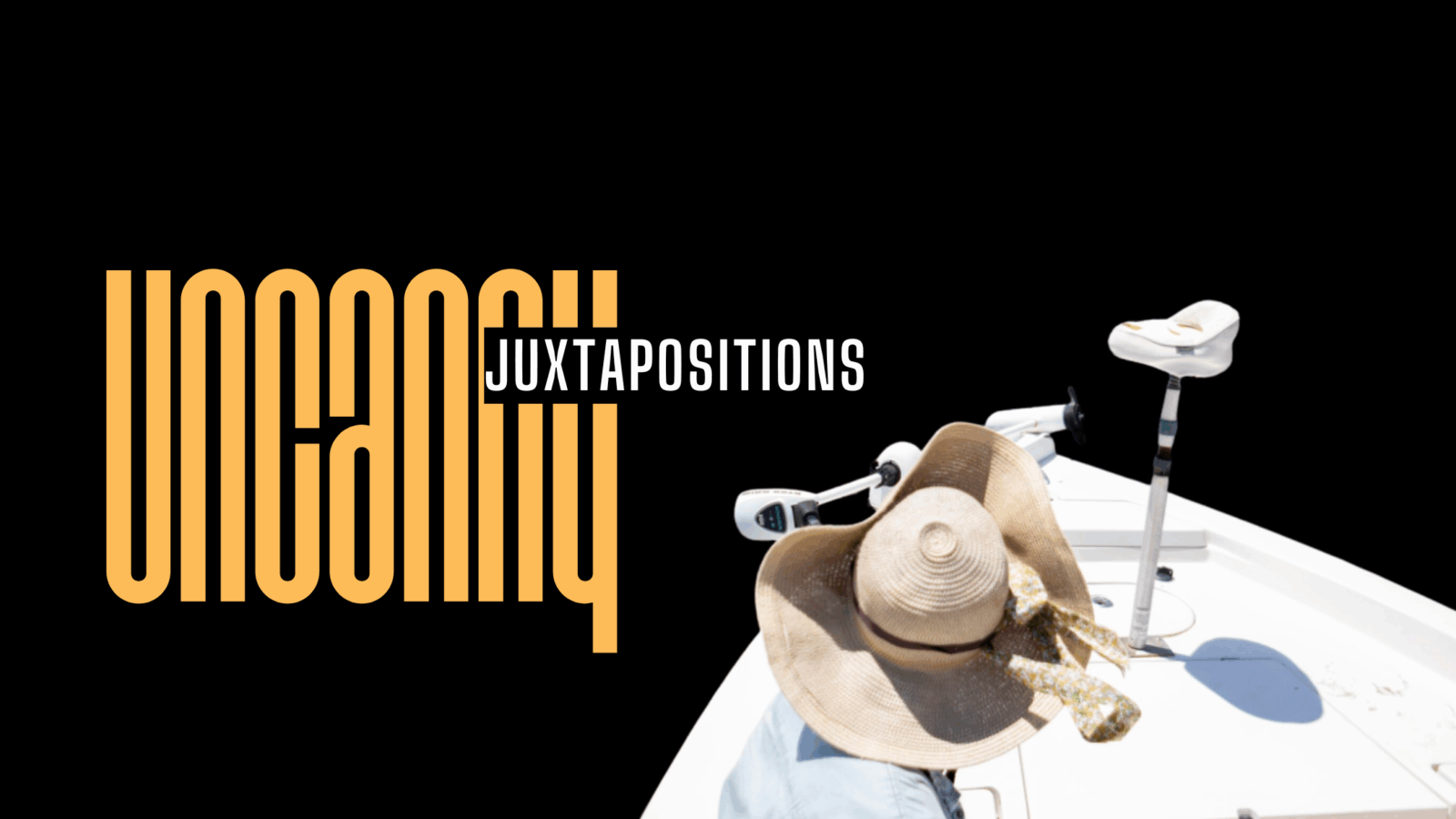In the 2025 installation “Shore|Lines,” exhibited at the Museum of Contemporary Photography (MoCP) in Chicago, Illinois, artist Regina Agu uses “the methodology of landscape panorama” to examine connections between the Black communities of the Gulf South and the Great Lakes. The comedy series Clean Slate (2025), created by and starring trans actress and advocate Laverne Cox, also frames the landscape to establish the protagonist Desiree’s belonging to her Southern hometown after her return from New York. The works look at the Great Migration (Agu) and mirror the reverse-migration from North to South happening more frequently today (Cox). Taken together, they unexpectedly create a continuum exploring past and present Black movement across the US. And they both do so through the technique of the panorama, whose eerie ability to accurately represent places and events has historically been considered a defining feature of the medium. According to Allison Griffith, “As a perceptual apparatus for framing human vision, [the first] panoramas were frequently promoted with an appeal to the notion of the reenactment as a way of foregrounding the uncanny mimetic prowess of the technology.”1
“Shore|Lines” consists of five large-scale panorama prints, one miniature panorama, three standalone inkjet prints, and several sets of photographic prints hung in the salon style. As the exhibition wall text states, Agu uses panorama to express “her passion for her various home regions.” The artist claims multiple homes across the United States and beyond and excavates the histories of each place, considering how their different pasts reverberate through each other.2 Agu uses panorama to communicate the interconnectedness of the experiences of Black communities in diverse parts of the world. Throughout the exhibition, Agu especially connects the Northern and Southern United States by representing both regions through stratified photographs. “By using overlapping visuals,” the wall text continues, “Agu emulates layers of time, history, and multiple site visits to interconnected locations.” With the expansive, connected display of these pieces, “Shore|Lines” creates a space where specific Black places in different regions and different time periods meet and exist together.
In doing so, the artist engages scholar Katherine McKittrick’s notion of Black geographies. McKittrick illuminates how the connection that Black people have with the land, whether in diaspora or on indigenous lands, is rigorous and tangible as well as emotional. This relationship offers specific ways of seeing, understanding, and depicting the world. Part of the power of this Black geographical knowledge is to refuse the ways that space has been used to oppress Black populations.3 Agu takes up Black geographies as a practice by employing panorama to render a sense of place that centers Black people’s everyday lives, their relationships to land, and their resistance to oppression.
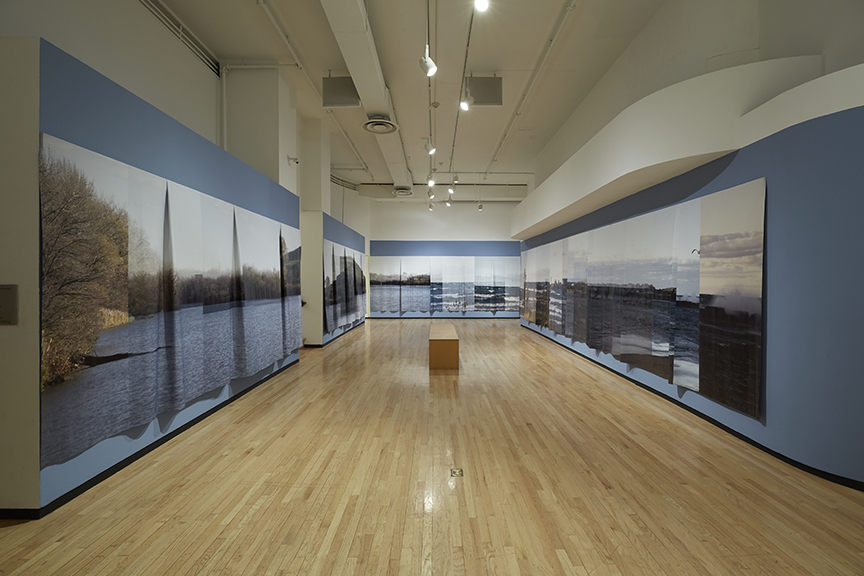
For example, consider one of Agu’s panoramas in “Shore|Lines”: Edge, Bank, Shore, which portrays sites in and around Chicago including the historically Black neighborhoods Bronzeville and Douglas, the African American Heritage Water Trail, and Rainbow Beach. Scores of Black travelers walked the route now known as African American Heritage Water Trail during the Great Migration (1910–1970) and the time of the Underground Railroad (from the late 1700s to the mid- to late 1800s), while Rainbow Beach was the site of a protest for integration during the Civil Rights Movement of the 1960s. As the wall text states, “Local civil rights demonstrators staged a public ‘wade-in’ at the beach [in 1961], employing protest tactics modeled by students and activists in the American South.” Edge, Bank, Shore thus connects the Northern and Southern United States by reflecting on Black migration and the influence of the Southern Civil Rights Movement on Black communities in the Midwest.
Images of Rainbow Beach, the African American Heritage Water Trail, Bronzeville, and Douglas appear side by side in the panorama, forming them into a seamless whole. In this way, the work connects these locations and the histories that inform their present. Picturing sites of Black resistance, migration, and dwelling alongside each other, Edge, Bank, Shore elucidates how prior movements, both political and geographical, brought about local Black life today. And it does so through the power of the panorama to provide the illusion of a wholly and precisely reproduced landscape.
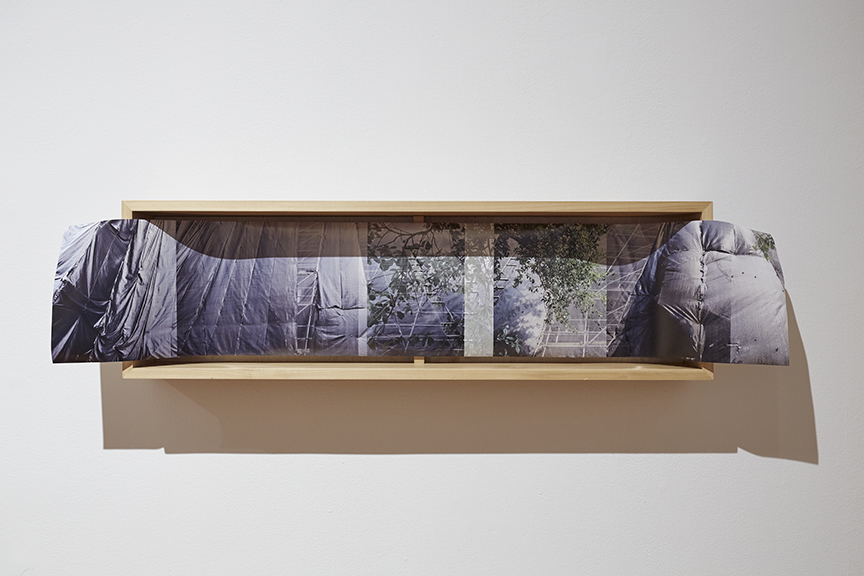
Similarly, Drape Panorama 02 consists of a series of digitally fused photographs displayed within a small wooden frame. Tarps appear across the photographs, connecting this work to the photographs in Agu’s Garden Before Hurricane Harvey photography series (2024). While tarps in that series allude to the effects of natural disaster, in Drape Panorama 02, they reference a human crisis: gentrification. As the wall text states, the work “abstracts common features of gentrifying cities” by collaging together spaces in various cities to create one continuous panorama. A blue tint creates a sense of cohesion across the still photographs. Yet this is interrupted by the clear green of the tree branches visible in one image. The light shining on the branches casts a shadow on the tarp below, which creates the impression of looking up at the sky despite the camera’s downward angle. These aesthetically pleasing elements point to the persistence of natural life despite the overbearing quality of imposed, manmade structures.4
Migration and gentrification are also at play in Laverne Cox’s Clean Slate. Desiree, a 40 year-old Black trans woman gallerist who can no longer afford to live in New York City, travels back to Mobile, Alabama, the Southern town where she grew up.5 This premise links the Northern and Southern United States from the show’s outset, a connection that is strengthened over its eight episodes as Desiree alludes to her New York life. Her cosmopolitan practices—at one point, she tries to get her father, Harry, to drink matcha—although thwarted by New York’s untenable economics, are set against the provincialism of Mobile. Yet the series demonstrates how the Alabama town can nurture Desiree interpersonally in a way that she found impossible up north.
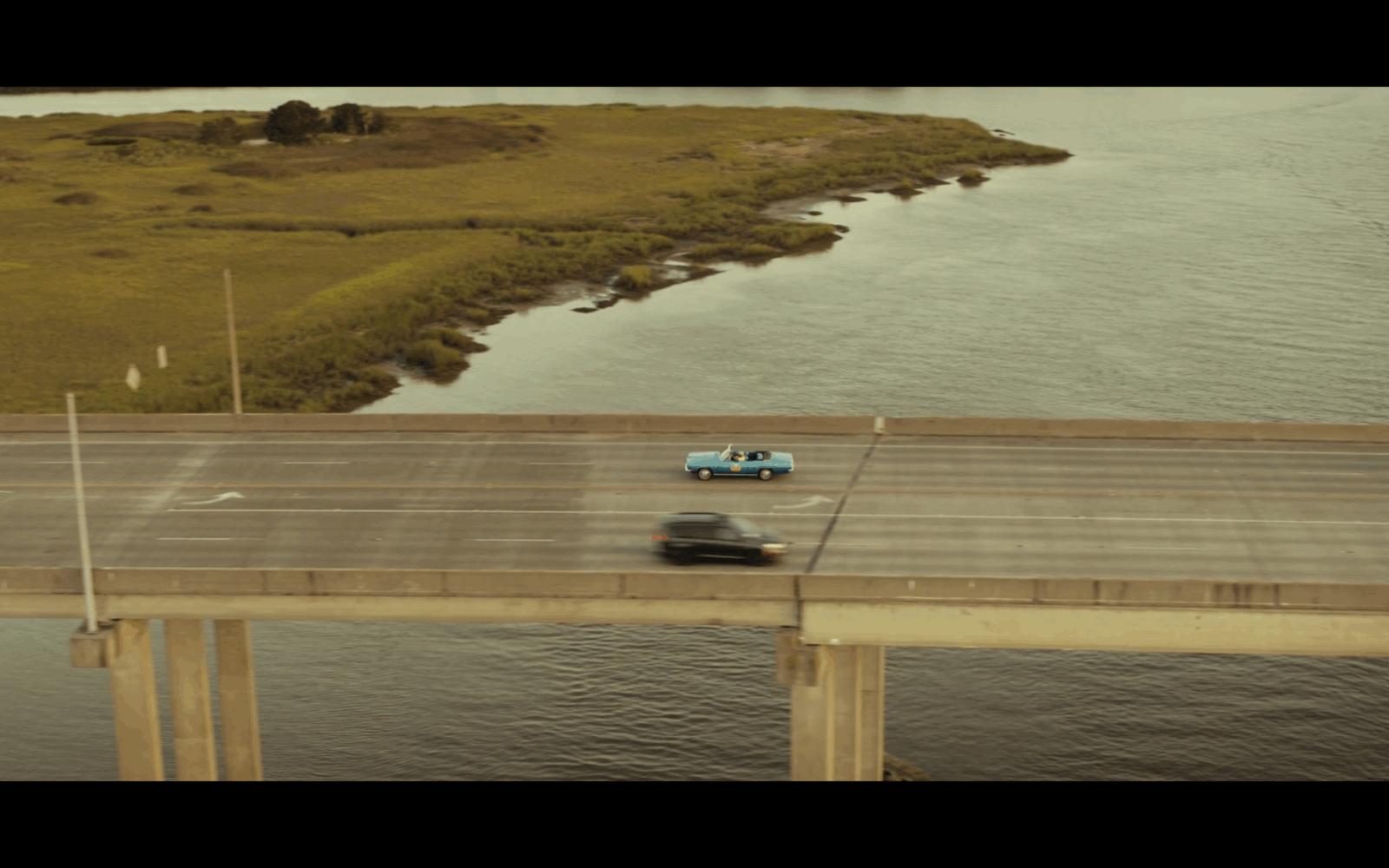
The series begins with an aerial shot of Harry driving across a bridge in his vintage car. The shot connects to Agu’s use of panorama as both offer an immersive view of the landscape6 and reinforces the show’s exploration of movement and the importance it accords to water. Agu’s exhibition, too, especially through its portrayal of sites in Chicago, asserts that bodies of water are not just proximal to Black communities but “defining sites of Black life and belonging.” In Clean Slate, following a failed attempt to compel a transphobic pastor to change the gender on her birth certificate, Desiree’s family and friends re-baptize her in the water of Harry’s car wash.7 Here and elsewhere, the series echoes McKittrick’s Black geographies, expressing how Black experiences are not only racial and gendered but also spatial. Clean Slate harnesses the restorative power of water to affirm Desiree’s right as a Black trans woman to determine not only her gender, but also her home.
Like Agu’s work, which, while devoid of Black figures, represents Black places, Clean Slate represents a Black community. As Harry drives through his neighborhood, his leisurely ride is punctuated as he stops to talk with friends. The Southern locale is activated and made more specific by these social exchanges. Though decidedly multiracial, the world of the story is anchored in the relationship between Harry and Desiree and their close friends Ella and Louis, who essentially act as a surrogate mother and brother to Desiree.

When the viewer first meets Desiree, she is traveling to Mobile on a bus, which underscores the show’s theme of return. When she reaches town, the trees outside of the bus station make this scene continuous with the previous scene of her father. The local landscape connects the two characters despite their decades-long estrangement. Clean Slate continues to use nature to illustrate Desiree’s belonging to Mobile and its people. When Desiree knocks on her father’s door and reveals that she is trans, the Spanish moss in the background frames her body with its soft lushness. These geographically specific trees connect Desiree to the land and to her home despite how her father’s initially ignorant reaction threatens her claim to a rightful place here.
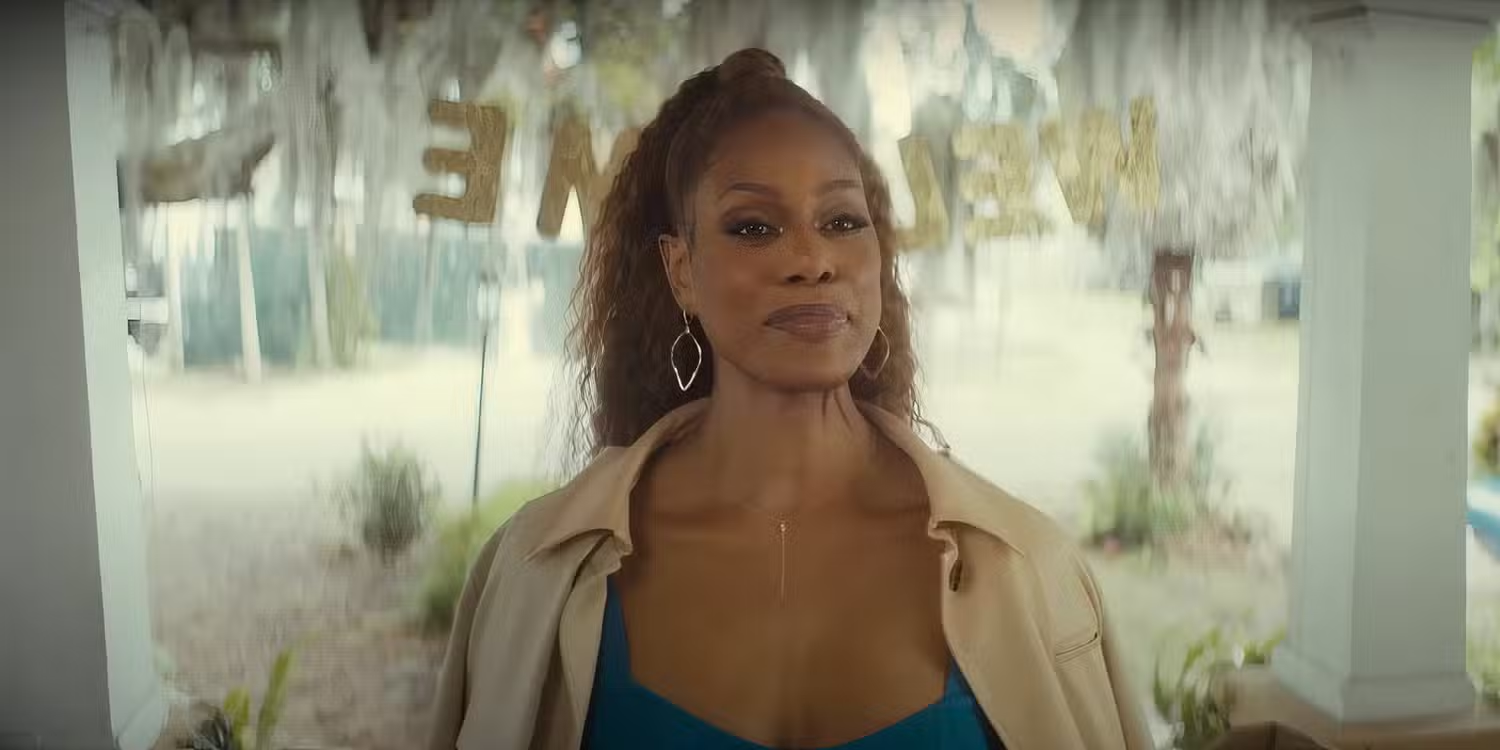
As Desiree endeavors to make a new life in her old home, she eschews decisions commonly associated with gentrification. For example, rather than rent a luxury apartment, she moves into her father’s old, cluttered home. Despite her professional experience and need for a job, she works for Harry at the car wash rather than starting a new art gallery. In these ways, Desiree avoids actions that might contribute to increasing local housing costs or displacing existing businesses. Though this is presumably out of necessity, as Desiree conveys that she is cash strapped, and while one person cannot singlehandedly cause gentrification, Clean Slate offers an image of a migrant who embeds herself in her community rather than aiding in erasure and adding to economic pressure. Desiree draws on her connections with her father and chosen family to make living in Mobile feasible for herself and to positively impact others. Through Desiree, Clean Slate visualizes a way of inhabiting space that is first and foremost informed by interdependence and repair rather than economic or personal gain.
Contemplating Agu’s installation alongside Cox’s show unveils the works’ shared theme of migration. Both works center Black people in transit and in space, though each adopts a different approach to this subject. The representational strategy of “Shore|Lines” is oblique, while Clean Slate depends on its characters to advance its narrative. Making connections to the Northeast and Midwest, both works look to the South as a place worthy of exploration for its relationship to Black communities within the region and beyond. In “Shore|Lines,” the use of panorama brings important sites and histories together into one absorbing experience of Black place. In Clean Slate, the landscape binds the Black migrant more tightly to her community and her home. Both works offer a critical lens on the costs of geographical movement. Through these techniques, the series and the installation put forth sweeping yet thoughtful perspectives on how Black communities move through and create home spaces today.
: :
Endnotes
- Alison Griffith, “‘Shivers Down Your Spine’: Panoramas and the Origins of the Cinematic Reenactment” Screen 44, no. 1 (Spring 2003): 8.
- See Allison K. Young, “Visuality and the Plantationocene: The Panoramas of Regina Agu” Panorama: Journal of the Association of Historians of American Art 8, no. 1 (Spring 2022).
- As McKittrick writes, “Geographies of domination, from transatlantic slavery and beyond, hold in them both the marking and the contestation of old and new social hierarchies. If these hierarchies are spatial expressions of racism and sexism, the interrogations and remappings provided by black diaspora populations can incite new, or different, and perhaps more just, geographic stories.” Katherine McKittrick, Demonic Grounds: Black Women and the Cartographies of Struggle (University of Minnesota Press, 2006), xix.
- Another of Agu’s works, a photograph entitled Mud Dredge, Mississippi River Delta (2019), similarly connects “human intervention” to the potential loss of nature. In this work, a gray tidal wave shrouds a stretch of the Mississippi River. This wave is the product of dredging, a practice that removes waste from rivers but also destroys important minerals. The ominous appearance of the wave looming over the landscape calls to mind the climate crisis, the direct and extensive result of shortsighted, harmful practices like dredging. Displayed with other photographs of the Mississippi River, Mud Dredge emphasizes the essential nature of this water body and the various disasters the local area has suffered, both natural and manmade.
- Filmed in Savannah, Georgia, Clean Slate evokes Mobile through landscapes and locations that paint the picture of a recognizably Southern, if somewhat generic, coastal town. In this way, the show visually represents not only Mobile but also other similar cities across the South, enfolding the wider region into its narrative of migration.
- See S. Piteri, “A Comparison Between Panoramic Photography and Conventional Aerial Photography in Terms of Mapping Accuracy” Earth Moon Planet 40 (1988): 295–302.
- In this small town, the church manages such legal documents.
